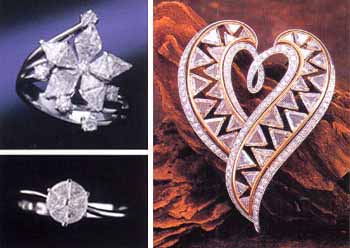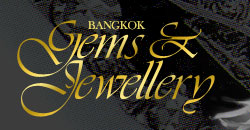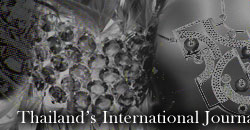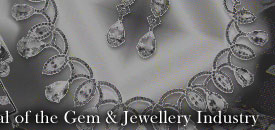| |
| |
True North Gems Inc. has announced the
acquisition of an option to earn a 100% interest in the Fiskenaesset
ruby property in Greenland. The acquisition fulfils the Company's
business strategy of obtaining a portfolio of properties with
the "Big three" coloured gemstones: emeralds, rubies
and sapphires. True North Gems believes the Fiskenaesset ruby
property has excellent potential to be a secure, long-life mine
source for a lucrative gemstone polishing operation.
|
|
|
|
Field investigations
planned for 2004 include prospecting to quantify the extent of
the surficial and bedrock deposits. Trus North's field crew will
select bulk sample sites, and identify drilling targets. At the
same time, the Company will also examine different recovery techniques
to liberate ruby from the host rock, authenticate the unique geological
properties of the Greenland ruby, and engage in a preliminary
market test for new gemstone and jewellery products.
The 5,500-hectare Fiskenaesset ruby property
is located in the Qeqertarsuatsiaat diatrict, 160 kilometres south
of the capital, Nuuk. Ruby was first discovered in the district
in 1953 and to date, 50 tonnes of high grade ruby are have been
produced. The area has seen intermittent exploration and artisanal
production since 1972. In 1981, a carefully collected, 1.36 tonne,
mini-bulk sample processed to completion yielded 340 grams of
rough ruby, including approximately 21 grams of good-quality polishable
material.
|
|
|
The
Greenland rubies are found along the contact between layered anorthosite
and amphibolite, where they formed during regional metamorphism
in the Archean. The Fiskenaesset anorthosite complex has also been
shown to contain rich chromitte deposits. The favourable mineralised
contact zone can be traced over a folded strike-length of nearly
200 kilometres. Rubies are part of a metamorphic mineral assemblage
that includes over 50 minerals, including sapphirine, pargasite,
cordierite and spinal. Ruby is relatively abundant and widespread
in this setting, with individual crystals growing up to over 1 cm
in size.
With the acquisition
of the Fiskenaesset ruby property, true North Gems has a property
portfolio that includes all three, namely: emerald from Regal
Ridge in the Yukon, sapphire from Kimmirut on Baffin Island, and
ruby from Qeqertarsuatsiaat on Greenland.
|
|
|
|
|
|
|
|
|
|
|
|
|
|
|
|
|
|
 |
|
|
A
Canadian firm will invest US$12 million in the Capital emerald mine,
which belongs to Zelen Kamen (Greenstone), Donald Padgett, president
of Canada's Tsar Emerald Corp., announced after meeting with Viadimir
Molchanov, first deputy chairman of the Sverdlovsk Region says a
report from the Russian media.
As relayed by the press
service of the region's Ministry of industry, energy and Science,
Zelen Kamen is in the business of mining emeralds and other valuable
minerals. The Firm's principal stockholders are Noffin and Kabal
Development Ltd. Tsar Emerald has been brought in to provide the
financing to make possible resumption of direct mine extraction
of emeralds at the Capital site.
|
|
|
|
|
|
|
|
In
addition to Padgett, participants in the negotiations included Brenden
Stanley, who is general director of is general director of Zelen
Kamen nad Kabal, and Paul Portis, vice president of Norfin. Padgett
said talks are now in progress with a number of Ukrainian bureaus
on the redesign of the Capital mine.
Molchanov noted in his
remarks the need to bringin the most modern technology and equipment
for the mine and to deal with related social problems. Tsar Emerald
is to present the regional administration with its business plan
for the mine by June 1, 2004. The mine is to be back in operation
by December 2005. |
|
|

|
|
|
|
|
|
 |
|
|
First
there was the old mine cut and the table cuts and the variations
of the estimable rose cut that is now making a huge comeback. Then
came the full cut brilliants, which reigned as the best way in which
to maximize the adamantine brilliance within the diamond and bring
it to the fore in all its scintillating glory. For decades upon
decades, the fourth C, namely Cut, was quite restricted in its feild.
Most were shape variants of the brilliant - like the princess, pear,
marquise, ovals, trillions, hearts, etc.
Lately however,
there has been a sort of revolution in diamond cutting. Earlier,
the idea was just to save as much of the weight as was possible,
innovation be damned. That attitude has certainly gone the way
of the dinosaur. Today cut is approached with the same eye for
final appearance as is done with jewellery design. As a matter
of fact, today diamond jewellery design is now being dictated
by the cut of the stone.
|
|
|
|
|
|
The three most famous diamonds cuts developed
by Israeli diamond house Lili Diamond, namely the star cut, the
lili cut and the criss cut. These three cuts have taken the craft
of diamond cutting to artistic heights and are startlingly different
from the other fancies of this generation which work around variations
of the brilliant, nor do their shapes confirm to the natural shape
of the rough, so it is not a question of a kind cut to save weight.
The fire and beauty they import to the finished jewel can be witnessed
in the rings at left, which use criss cut diamonds as their centre
stone. |
|
|
Earlier,
jewellery designers had to turn to semi precious stones for fancy
shapes that were incorporated into jewels making them hard to replicate
cost effectively. Now the same can, to a certain extent, be done
with diamonds as well. There is now a huge emerging trend for diamond
jewellery based on special cuts that would simply not adapt themselves
as effectively to being studded with brilliants or any other shape.
The jewel's design succeding therefore offers a guarantee that the
cut itself will succeed as well.
So
you have the Lady Heart diamond jewels that must have half moon
cut diamonds with a princess cut stone in order to cheaply replicate
the effect of a much larger heart shaped diamond that would require
an ordinary consumer to win a lottery to be able to affort it. |
|
|
|
|
|
1. The frame cut lends
itself marvellously to new designs that would have had to depend
on the use of metal for its shape in an earlier era.
3. Invisible setting using princess cuts were first created by Van
Cleef & Ampels to give the appearance of a larger stone using
many small ones. |
|
|
This
brings to mind the trend that popularised the princess cut in the
first place. We are talking of course of Van Cleef & Arpels'
famous invisible setting that was created precisely to give the
effect of a single large prohibitively expensive stone using many
small affordable ones. The original jewels focused on making larger
squares out of small princess cut diamonds to give the effect of
a single princess cut gem of multi carat weight. Of course that
design trend was replicated all over the world and now invisible
setting is used not only in geometrically precise shapes but also
free flowing designs that take the shape of a feather, a leaf, a
flower or more.
The net effect
was that the princess became one of the most popular cuts, second
only to the round brilliant. Its popularity spilled forward from
diamonds into colour stones and now, especially in ruby sapphire,
try looking for a parcel of ordinary squares, everybody is carrying
princess. |
|
|
If
only the originator of the princess cut could have foreseen its
popularity, he would have copyrighted it. That is exactly what cutters
are doing with their new innovations now. Advancement in diamond
cutting and polishing technology has created a new breed of cutters
who are artists as well. With the rapid advancements in science
and technology, they need not reign in their imagination any more.
The
first seriously avant-garde shape in diamond cutting was probably
the five-pointed star that was cut out of the round. At the time
many had their doubts whether there could ever be a real market
and any sort of serious demand for stones of this kind. To start
with, the weight loss in such a cut was tremendous and completely
out of proportion with what one could get from the standard brilliant.
Secondly, its price was as tounding, as it was not calculated on
the weight of the stone but on the presumed carat weight of a round
diamond of the same diameter, which means that effectively, you
were paying for the notional value of design and not for the commodity
weight of the gem, as was the norm. This made it the first designer
cut ever for diamonds on a commercial basis. It was the first but
more were to follow shortly. |
|
An example of the plethora
of new cuts that abound in the market.
1.Empress
Cut 2. Grace Cut 3. Duchess Cut 4. Baroness Cut
5.
Two half moons and a princess are creatively teamed to produce a heart
shape. |
|
|
The
current line up of fancies is unparalled. The Lili Cut, Criss Cut,
Flame Cut, Royal Asscher Cut, web Cut, etc. are shapes that draw
designer to create jewels bases on them like th etapers and baguettes
of old. Recently, the web Cut was also used in a special limited
edition handbag by Delvaux that made it to the pages of every gem
and jewellery and fashion magazine worth its salt. Sure fancies
are expensive, but with the growing consumer demand for diamond
jewellery and the expensive promotional campaigns that are being
launched, diamond jewellery manufacturers and diamantaires themselves
have realized that in the world of luxury, price is a secondary
consideration. the luxury conscious consumer is really looking for
something that the hoi polloi don't have. Something that takes real
money to buy.
As the diamantaires
begin shedding the grocer mentality that accorded price and only
price as the premium factor in sales, a phenomenon that swept across
the diamond centres in the early 1990's thanks to a glut of supplies,
innovation has set in. To be certain, oversupply is still a factor
for concern but now the means of tackling this issue has changed
with the rise of market savvy and consumer identification that is
prevalent post Supplier of Choice. |
|
|
|
|
|
1-2 Emerella cut, an
innovative patent pending process that seamlessly joins nine diamonds
to look like a single large one. Eight trapezoid diamonds set around
a smaller emerald cut give the optical effect of a larger one, offering
face up sizes that range from 1.5 - 5 carats.
3-6 The web cut was used by Delvaux in this limited edition handbag. |
|
|
Even
the ubiquitous brilliant is changing shape and taking on new avatars,
the most recent of which is the Star 129, a round with a mind boggling
hundred and twenty nine facets. To popularise it, Suashishstar,
creatoes of the Star 129 commissioned top British designer Stephen
Webster to create a set of jewels to highlight the stone and one
can be certain that a gem of this almost celestial radiance will
certainly never be desecrated by being dumped into an ordinary less
than inspiring design.
|
|
|
It
may seem like there are a plethora of fancy cuts, most of
them variations of the round brilliant and that the market
is being saturated. Not so, the consumer is a fickle lover,
with a taste that changes faster than a chameleon's colours.
Always looking for something new, something that nobody else
has and it is this instiable appetite that will fuel the growth
of this specialization.
To sell their stones,
diamantaries therefore will have to continue innovating, and
what is more, they will have to present the cuts in specially
made designs in order to differentiate their product and create
a demand for it. The dynamics of the diamond market are thus
changing faster in a half decade than they had in the entire
history of the trade. One company alone, Gitanjali Exports,
has filed for patents for 25 new cuts and that should more
than anything else give an indication that this facet of the
industry is going to be very commonplace soon. |
|
 |
| |
|
Triangle cut stones can be invisibly set to simulate
the effect of a single
large round brilliant or they can be used in various design
combinations
for maximum visual appeal. |
|
|
| |
|
|
|
|
|
|
|
|
|
|
|
|
|
|
|
|
|
|
|
|
|
|
|
|
|
|
|
|
|
|
|


